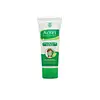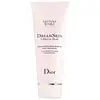What's inside
What's inside
 Key Ingredients
Key Ingredients

 Benefits
Benefits

 Concerns
Concerns

 Ingredients Side-by-side
Ingredients Side-by-side

Water
Skin ConditioningButylene Glycol
HumectantBentonite
AbsorbentKaolin
AbrasiveGlycerin
HumectantTriethylhexanoin
MaskingTitanium Dioxide
Cosmetic ColorantIllite
AbrasiveMelaleuca Alternifolia Leaf Oil
AntioxidantPhenoxyethanol
PreservativeXanthan Gum
EmulsifyingPolysorbate 20
EmulsifyingDipotassium Glycyrrhizate
HumectantMethylparaben
PreservativeDisodium EDTA
Propylparaben
PreservativeAlcohol
AntimicrobialPEG-60 Almond Glycerides
EmulsifyingCaprylyl Glycol
EmollientAloe Barbadensis Leaf Extract
EmollientEthylparaben
PreservativeCarbomer
Emulsion StabilisingNordihydroguaiaretic Acid
AntioxidantOleanolic Acid
Skin ConditioningCI 42053
Cosmetic ColorantCI 19140
Cosmetic ColorantWater, Butylene Glycol, Bentonite, Kaolin, Glycerin, Triethylhexanoin, Titanium Dioxide, Illite, Melaleuca Alternifolia Leaf Oil, Phenoxyethanol, Xanthan Gum, Polysorbate 20, Dipotassium Glycyrrhizate, Methylparaben, Disodium EDTA, Propylparaben, Alcohol, PEG-60 Almond Glycerides, Caprylyl Glycol, Aloe Barbadensis Leaf Extract, Ethylparaben, Carbomer, Nordihydroguaiaretic Acid, Oleanolic Acid, CI 42053, CI 19140
Water
Skin ConditioningGlycerin
HumectantPolysorbate 20
EmulsifyingGlycolic Acid
BufferingButylene Glycol
HumectantHydroxyethyl Acrylate/Sodium Acryloyldimethyl Taurate Copolymer
Emulsion StabilisingCI 77891
Cosmetic ColorantHydrogenated Polyisobutene
EmollientAlcohol
AntimicrobialCitric Acid
BufferingSodium Hydroxide
BufferingSimmondsia Chinensis Seed Oil
EmollientParfum
MaskingXanthan Gum
EmulsifyingDipotassium Glycyrrhizate
HumectantPhenoxyethanol
PreservativeXylitol
HumectantPolysorbate 60
EmulsifyingSorbitan Isostearate
EmulsifyingTetrasodium EDTA
Ascorbyl Glucoside
AntioxidantSynthetic Fluorphlogopite
Malva Sylvestris Extract
AstringentHibiscus Sabdariffa Flower Extract
Skin ConditioningZea Mays Starch
AbsorbentHydrogenated Lecithin
EmulsifyingSaponins
CleansingLimonene
PerfumingPentaerythrityl Tetra-Di-T-Butyl Hydroxyhydrocinnamate
AntioxidantAframomum Angustifolium Seed Extract
Skin ConditioningPalmaria Palmata Extract
Skin ProtectingSodium Benzoate
MaskingTin Oxide
AbrasivePotassium Sorbate
PreservativeTocopherol
AntioxidantJasminum Officinale Flower Extract
MaskingCI 14700
Cosmetic ColorantWater, Glycerin, Polysorbate 20, Glycolic Acid, Butylene Glycol, Hydroxyethyl Acrylate/Sodium Acryloyldimethyl Taurate Copolymer, CI 77891, Hydrogenated Polyisobutene, Alcohol, Citric Acid, Sodium Hydroxide, Simmondsia Chinensis Seed Oil, Parfum, Xanthan Gum, Dipotassium Glycyrrhizate, Phenoxyethanol, Xylitol, Polysorbate 60, Sorbitan Isostearate, Tetrasodium EDTA, Ascorbyl Glucoside, Synthetic Fluorphlogopite, Malva Sylvestris Extract, Hibiscus Sabdariffa Flower Extract, Zea Mays Starch, Hydrogenated Lecithin, Saponins, Limonene, Pentaerythrityl Tetra-Di-T-Butyl Hydroxyhydrocinnamate, Aframomum Angustifolium Seed Extract, Palmaria Palmata Extract, Sodium Benzoate, Tin Oxide, Potassium Sorbate, Tocopherol, Jasminum Officinale Flower Extract, CI 14700
Ingredients Explained
These ingredients are found in both products.
Ingredients higher up in an ingredient list are typically present in a larger amount.
Alcohol comes in many different forms. Different types of alcohol will have different effects on skin. This ingredient is usually an astringent alcohol.
These alcohols are drying on the skin. They may strip away your skin's natural oils and even damage your skin barrier. Astringent alcohols may also irritate skin.
Other types of astringent alcohols include:
According to the National Rosacea Society based in the US, you should be mindful of products with these alcohols in the top half of ingredients.
Any type of sanitizing product will have high amounts of alcohol to help kill bacteria and viruses.
Fatty alcohols come from plant oils such as coconut oil. These can help hydrate the skin and are non-irritating. Some fatty alcohols include cetyl and stearyl alcohol.
Learn more about AlcoholButylene Glycol (or BG) is used within cosmetic products for a few different reasons:
Overall, Butylene Glycol is a safe and well-rounded ingredient that works well with other ingredients.
Though this ingredient works well with most skin types, some people with sensitive skin may experience a reaction such as allergic rashes, closed comedones, or itchiness.
Learn more about Butylene GlycolDipotassium Glycyrrhizate comes from licorice root.
Extracts of licorice have demonstrated to have antibacterial, anti‐inflammatory, antiviral, antioxidant properties.
One component, glabridin, has extra potent antioxidant and soothing properties. It has also been found to block pigmentation from UVB rays in guinea pigs.
Licorice Root also contains a flavonoid. Flavonoids are a natural substance from in plants. Flavonoids also have antioxidant properties.
Another component, glycyrrhizin, has been found to have anti-inflammatory and antimicrobial benefits. This may make licorice root extract effective at treating acne. However, more research is needed to support this.
Liquiritin is one of the flavone compounds found in licorice. It has been found to help lighten skin by preventing tyrosinase from reacting with tyrosine. When the two react, protein is converted to melanin. Melanin is the substance in your body that gives your features pigmentation.
Licorice root is native to Southern Europe and Asia. It has been used in traditional Chinese medicine to help with respiratory issues.
Learn more about Dipotassium GlycyrrhizateGlycerin is already naturally found in your skin. It helps moisturize and protect your skin.
A study from 2016 found glycerin to be more effective as a humectant than AHAs and hyaluronic acid.
As a humectant, it helps the skin stay hydrated by pulling moisture to your skin. The low molecular weight of glycerin allows it to pull moisture into the deeper layers of your skin.
Hydrated skin improves your skin barrier; Your skin barrier helps protect against irritants and bacteria.
Glycerin has also been found to have antimicrobial and antiviral properties. Due to these properties, glycerin is often used in wound and burn treatments.
In cosmetics, glycerin is usually derived from plants such as soybean or palm. However, it can also be sourced from animals, such as tallow or animal fat.
This ingredient is organic, colorless, odorless, and non-toxic.
Glycerin is the name for this ingredient in American English. British English uses Glycerol/Glycerine.
Learn more about GlycerinPhenoxyethanol is a preservative that has germicide, antimicrobial, and aromatic properties. Studies show that phenoxyethanol can prevent microbial growth. By itself, it has a scent that is similar to that of a rose.
It's often used in formulations along with Caprylyl Glycol to preserve the shelf life of products.
Polysorbate 20 is made by combining ethoxylation of sorbitan, ethylene oxide, and lauric acid. It is a mild cleansing agent, surfactant, and emulsifier.
As a surfactant, it helps collect dirt and oils for washing. Emulsifiers prevent oils and water from separating.
Polysorbate 20 also adds scent to a product. Since it is made using sorbitol, it has a sweet scent. Sorbitol can also be found in fruits such as apples and peaches.
The lauric acid used to create Polysorbate 20 is often derived from coconuts.
Polysorbate 20 may not be fungal acne safe.
Learn more about Polysorbate 20Water. It's the most common cosmetic ingredient of all. You'll usually see it at the top of ingredient lists, meaning that it makes up the largest part of the product.
So why is it so popular? Water most often acts as a solvent - this means that it helps dissolve other ingredients into the formulation.
You'll also recognize water as that liquid we all need to stay alive. If you see this, drink a glass of water. Stay hydrated!
Learn more about WaterXanthan gum is used as a stabilizer and thickener within cosmetic products. It helps give products a sticky, thick feeling - preventing them from being too runny.
On the technical side of things, xanthan gum is a polysaccharide - a combination consisting of multiple sugar molecules bonded together.
Xanthan gum is a pretty common and great ingredient. It is a natural, non-toxic, non-irritating ingredient that is also commonly used in food products.
Learn more about Xanthan Gum